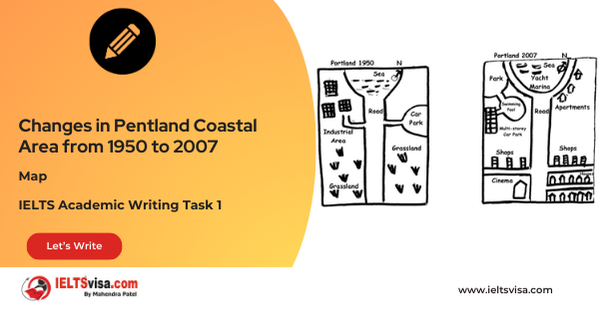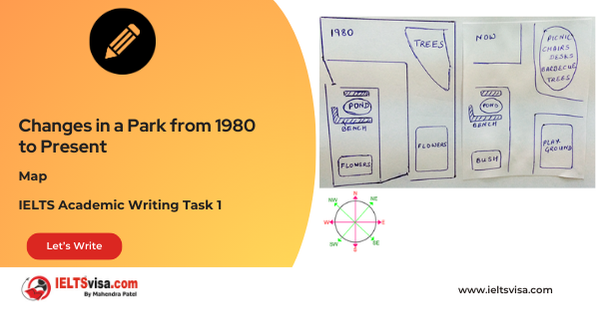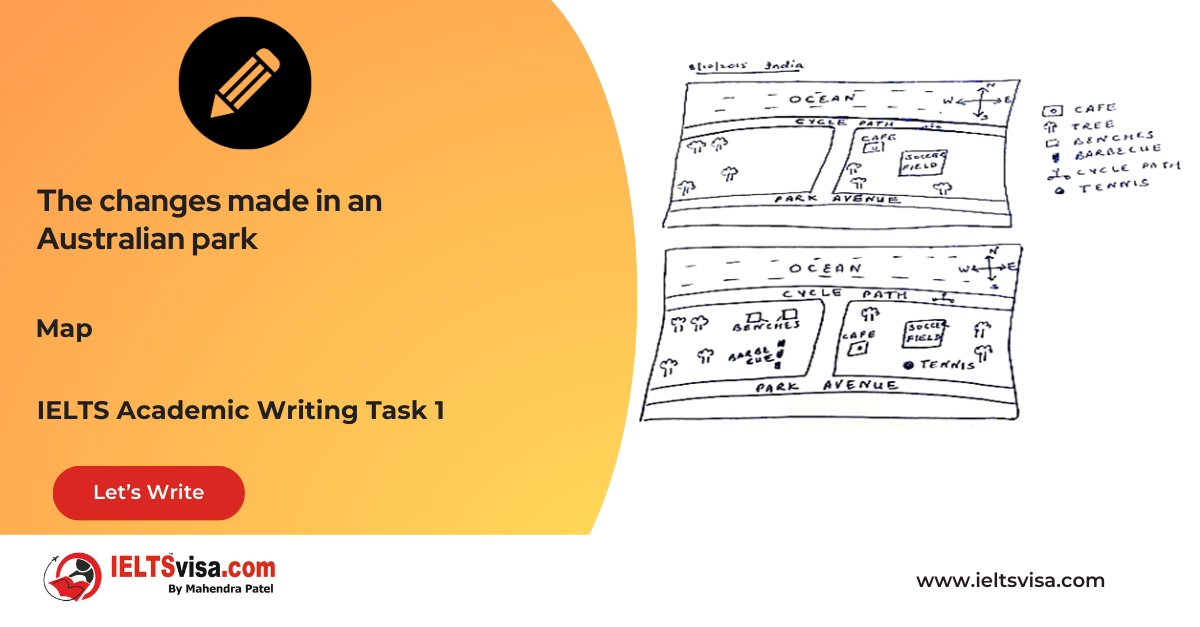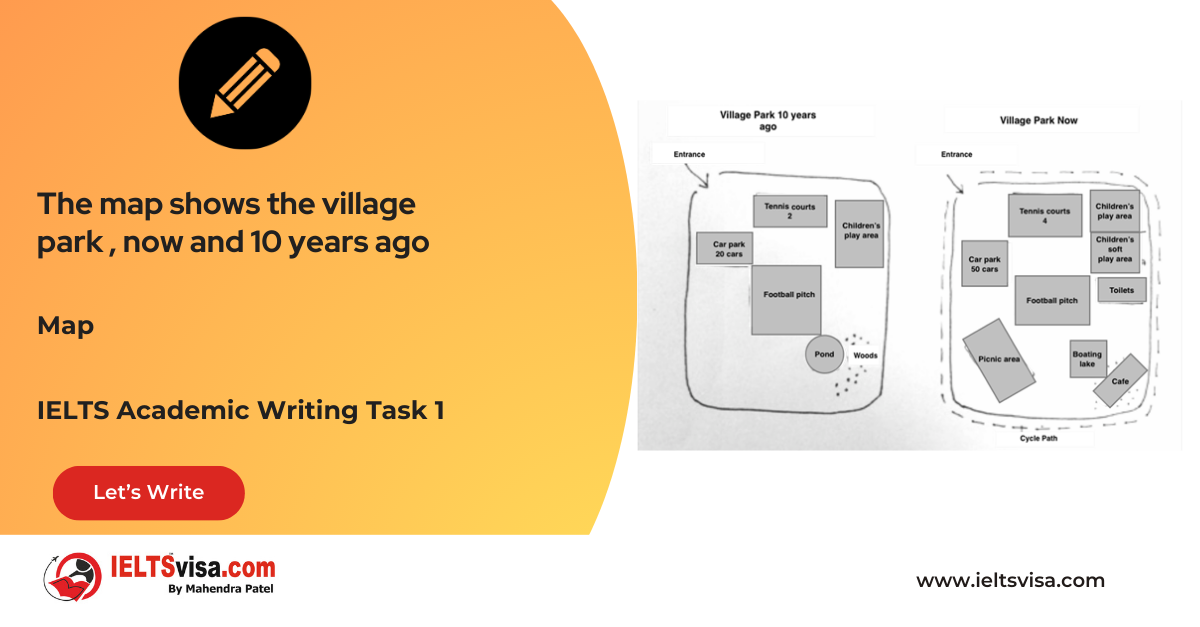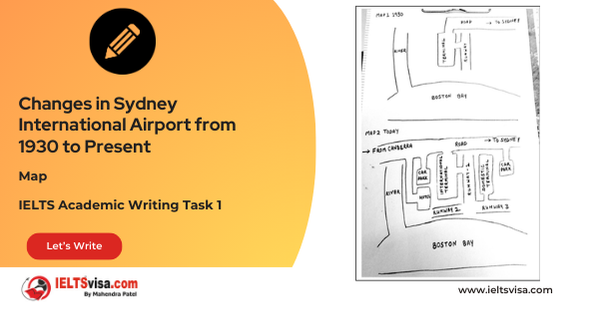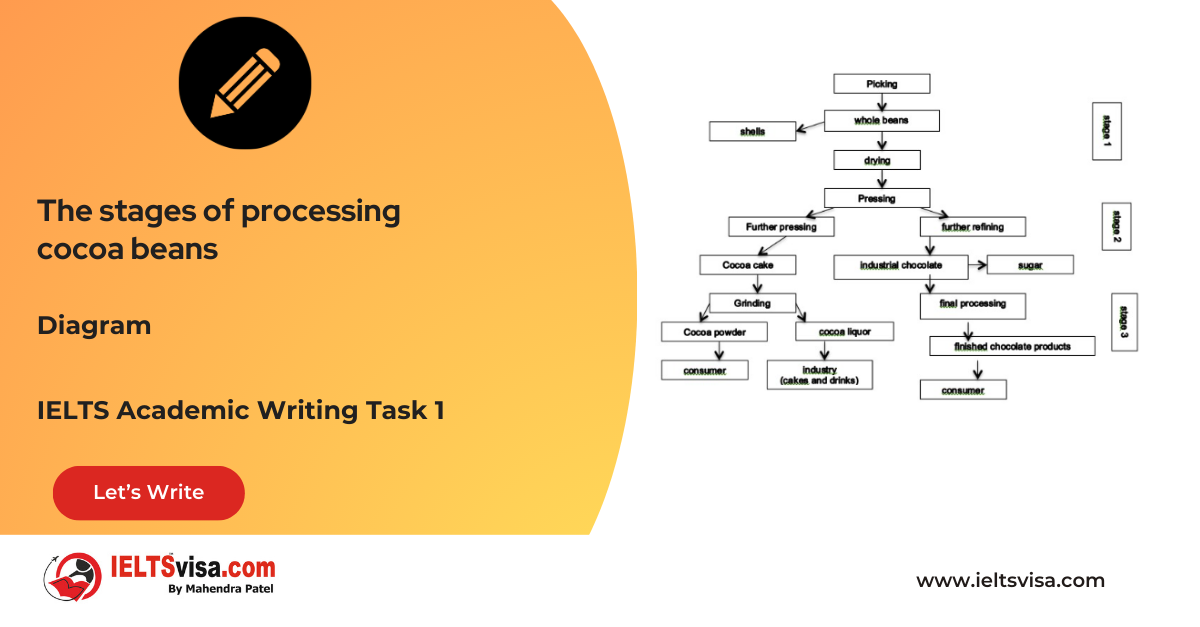Responses of different age groups to a questionnaire with their opinion about the range of books and the non-print material of a local library
IELTS Academic Writing Task 1 - Tables
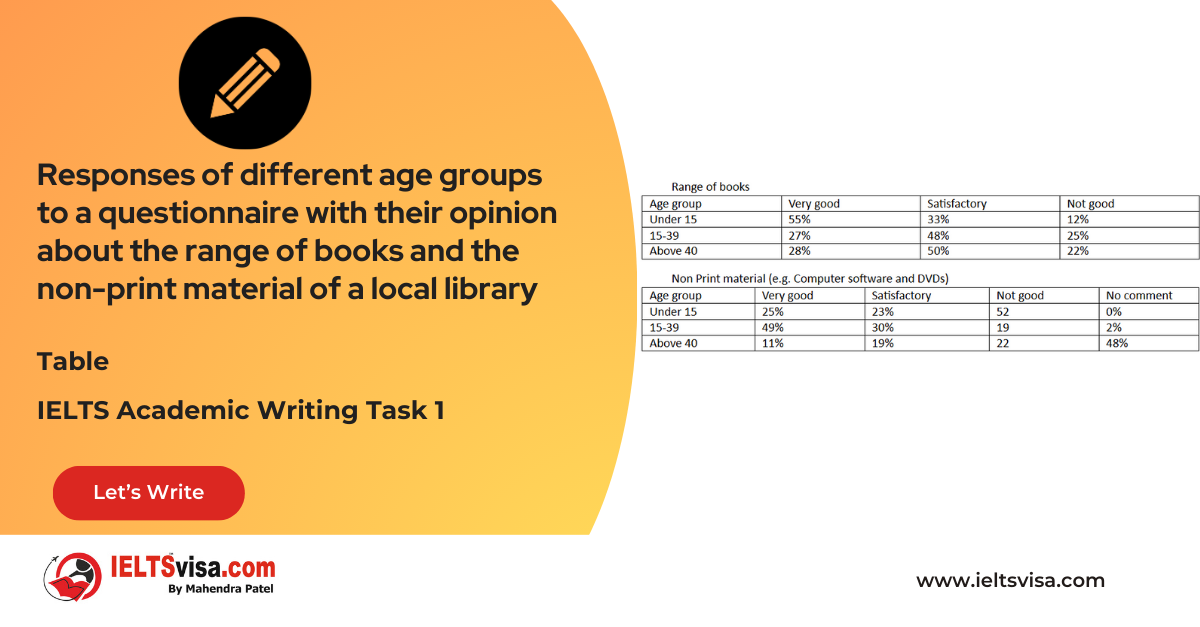
IELTS Writing Task 1 Question
The two tables below show responses of different age groups to a questionnaire with their opinion about the range of books and the non-print material of a local library. Summarize the information by selecting and reporting the main features, and make comparisons where relevant.

Common Questions for the Table
1. Graph Type: Two Tables
2. Title: Responses to Library Resources by Age Group (Books and Non-Print Material)
3. What are the units of measurement?: Percentage of respondents
4. Who: Different age groups (under 15, 15–39, above 40)
5. When: Not specified
6. Where: Local library
7. Topic: Ratings of print and non-print resources
Comparison Showing and Trends Any change over time (such as an increase or a decrease) is a trend.
Comparison 1 : Range of Books (Print Resources)
- Details:
-
- Under 15: Nearly 50% rated the range as very good, 33% as satisfactory, and about 10% as not good.
2. 15–39 and Above 40: Similar trends, with around 25% giving a “very good” rating and approximately 50% rating them as satisfactory. About 25% found the range not good.
Comparison 2 : Non-Print Material (Software and DVDs)
Details:
- Under 15: Half were dissatisfied, while 25% rated the material very good and another 25% satisfactory.
- 15–39: Nearly 50% rated the non-print material as very good, 30% as satisfactory, and around 20% as not good. Very few refrained from commenting.
- Above 40: Nearly half did not comment. About 11% rated the material as very good, while around 20% each rated it as satisfactory or not good.
Sample Answer
The two tables compare the opinions of three age groups—under 15, 15–39, and above 40—on the range of books and non-print materials (software and DVDs) available in a local library.
Overall, younger users were more critical of non-print resources, while older users tended to refrain from commenting.
For the range of books, nearly half of the under-15s rated it as very good, while 33% were satisfied and about 10% were dissatisfied. In contrast, only 25% of respondents in the 15–39 and above-40 groups rated the range very well. Around 50% of these age groups found the range satisfactory, and 25% considered it unsatisfactory.
Half of the under-15s expressed dissatisfaction with non-print resources, with the remaining split evenly between outstanding and satisfactory ratings. Among the 15–39 group, 50% rated the material as very good, 30% as satisfactory, and 20% as not good—only a tiny proportion withheld comments. Meanwhile, 50% of those above 40 chose not to comment. Of the rest, 11% rated the material very good, and 20% each rated it as satisfactory or not good.
Top 34 Vocabularies
| Vocabulary | Type | Meaning | Synonyms | Examples |
|
Resources |
Noun |
Supplies or materials used to meet needs |
Materials, Assets |
The library’s resources were rated differently by age groups. |
|
Proportion |
Noun |
A part or share of a whole |
Ratio, Fraction |
A significant proportion of respondents over 40 did not comment. |
|
Satisfactory |
Adjective |
Acceptable or adequate |
Sufficient, Passable |
Many users rated the range of books as satisfactory. |
|
Minority |
Noun |
A smaller group compared to the majority |
Subgroup, Few |
A small minority of the younger group did not comment. |
|
Contrast |
Noun |
A striking difference between two things |
Disparity, Opposition |
In contrast, older respondents refrained from commenting. |
|
Underrepresented |
Adjective |
Represented in insufficient numbers or degree |
Marginal, Few |
Ratings for non-print material were underrepresented by older groups. |
|
Divergence |
Noun |
A difference or variation |
Separation, Deviation |
There was a divergence in opinion between age groups. |
|
Predominantly |
Adverb |
Mainly or for the most part |
Chiefly, Primarily |
The older age group predominantly did not comment. |
|
Allocate |
Verb |
To assign or distribute |
Assign, Distribute |
Time and effort were allocated to rating non-print materials. |
|
Perception |
Noun |
The way something is understood or regarded |
Viewpoint, Interpretation |
The perception of the range of books varied across age groups. |
|
Assessment |
Noun |
The act of evaluating or judging |
Evaluation, Appraisal |
“The assessment of library resources varied across age groups.” |
|
Critical |
Adjective |
Expressing disapproval or judgment |
Judgmental, Analytical |
“Younger users were more critical of non-print materials.” |
|
Demographic |
Noun |
A specific segment of the population |
Population group, Sector |
“Each age demographic had unique opinions on the resources.” |
|
Dissatisfaction |
Noun |
A feeling of not being pleased or content |
Discontent, Unhappiness |
“Half of the under-15s expressed dissatisfaction with non-print materials.” |
|
Perspective |
Noun |
A particular way of viewing something |
Viewpoint, Outlook |
“The perspective on books differed between younger and older groups.” |
|
Unsatisfactory |
Adjective |
Not meeting expectations or standards |
Inadequate, Poor |
“25% of respondents found the book selection unsatisfactory.” |
|
Engagement |
Noun |
The act of being involved or participating |
Participation, Involvement |
“Engagement with non-print materials was higher among younger users.” |
|
Segmentation |
Noun |
The division of something into parts |
Division, Categorization |
“The segmentation of age groups revealed contrasting opinions.” |
|
Prominent |
Adjective |
Important or easily noticed |
Noticeable, Significant |
“Prominent differences were observed in their evaluations.” |
|
Noteworthy |
Adjective |
Deserving attention or notice |
Significant, Remarkable |
“The response from the older age group was less noteworthy.” |
|
Varied |
Adjective |
Differing in type or character |
Diverse, Mixed |
“Opinions on the range of books varied significantly.” |
|
Indicate |
Verb |
To point out or show |
Show, Demonstrate |
“The table indicates significant dissatisfaction among younger users.” |
|
Preference |
Noun |
A greater liking for one alternative over another |
Choice, Favoritism |
“The preference for books was higher among the under-15s.” |
|
Underwhelming |
Adjective |
Failing to impress or excite |
Disappointing, Insufficient |
“Non-print materials were deemed underwhelming by the younger users.” |
|
Subset |
Noun |
A smaller part of a larger group |
Subdivision, Fraction |
“The older users represent a subset of the overall respondents.” |
|
Adequate |
Adjective |
Satisfactory or acceptable |
Sufficient, Suitable |
“The range of books was considered adequate by most respondents.” |
|
Highlight |
Verb |
To emphasize or make prominent |
Stress, Emphasize |
“The responses highlight dissatisfaction among certain groups.” |
|
Significant |
Adjective |
Important or meaningful |
Notable, Considerable |
“A significant proportion of respondents rated the materials poorly.” |
|
Trend |
Noun |
A general direction in which something is developing |
Pattern, Tendency |
“A downward trend in ratings was noted among older age groups.” |
|
Neutral |
Adjective |
Not expressing a strong opinion either way |
Unbiased, Indifferent |
“Some respondents gave a neutral rating for the book range.” |
|
Insight |
Noun |
A deep understanding of something |
Understanding, Awareness |
“The data provides insights into age-based preferences.” |
|
Evaluation |
Noun |
The act of judging or determining the value of something |
Assessment, Review |
“The evaluation process varied between age groups.” |
|
Marginally |
Adverb |
Slightly or to a limited extent |
Barely, Slightly |
“Older users were marginally more satisfied with non-print materials.” |
|
Predominance |
Noun |
The state of being greater in number or influence |
Majority, Dominance |
“The predominance of dissatisfaction was observed in younger groups.” |

Our Books
Master IELTS Speaking Part 1
IELTS Writing Task 1 Book
IELTS Writing Task 2 Book
Writing Task 1 Question Types
Practice IELTS Other Modules
IELTS Listening
The IELTS Listening test assesses how well you can understand spoken English in various contexts. It lasts about 30 minutes and is divided into four sections with a total of 40 questions. The listening tasks become increasingly difficult as the test progresses.
IELTS Academic Reading
The IELTS Academic Reading section assesses your ability to understand and interpret a variety of texts in academic settings. It is designed to evaluate a range of reading skills, including skimming for gist, reading for main ideas, reading for detail, understanding inferences, and recognizing a writer's opinions and arguments.
IELTS Speaking
The IELTS Speaking test assesses your ability to communicate in English on everyday topics. It lasts 11-14 minutes and consists of three parts: introduction, cue card, and a discussion based on the cue card topic.
IELTS General Reading
IELTS General Reading tests your ability to understand and interpret various types of texts. Here are some key areas and types of content you can expect to encounter in the reading section, along with tips for effective preparation.
IELTS Academic Writing Task 1
In IELTS Academic Writing Task 1, you are presented with a visual representation of information, such as graphs, charts, tables, or diagrams, and you are required to summarize, compare, or explain the data in your own words.
IELTS General Writing Task 1
In IELTS General Writing Task 1, you are required to write a letter based on a given situation. The letter can be formal, semi-formal, or informal, depending on the prompt. Here’s a breakdown of the key components to include in your letter
IELTS Academic Writing Task 2
In IELTS Academic Writing Task 2, you are required to write an essay in response to a question or topic. Here’s a guide to help you understand the essential elements of this task
IELTS Exam Tips
To succeed in the IELTS exam, practice regularly, familiarize yourself with the test format, improve your vocabulary, develop time management skills, and take mock tests to build confidence.
Grammer for IELTS
Grammar is the foundation of effective communication in English. Understanding tense usage, subject-verb agreement, and sentence structure enhances clarity and coherence in writing and speaking.
Vocabulary for IELTS
Vocabulary plays a crucial role in the IELTS (International English Language Testing System) exam, especially in the Speaking and Writing sections. Here’s an overview of why vocabulary is important and how it impacts your performance
RECENT IELTS SAMPLES QUESTIONS AND ANSWERS
Task 1 – Map -Changes in Pentland Coastal Area from 1950 to 2007
[df_adh_heading title_infix="IELTS Writing Task 1 Question" use_divider="on"...
Task 1 – Map -Changes in a Park from 1980 to Present
[df_adh_heading title_infix="IELTS Writing Task 1 Question" use_divider="on"...
Task 1 – Maps – The changes made in an Australian park
20:00 Start Pause Stop [df_adh_heading title_infix="IELTS Writing Task 1 Question" use_divider="on"...
Task 1 – Maps- The map shows the village park, now and 10 years ago
20:00 Start Pause Stop [df_adh_heading title_infix="IELTS Writing Task 1 Question" use_divider="on"...
Task 1 – Map -Changes in Sydney International Airport from 1930 to Present
[df_adh_heading title_infix="IELTS Writing Task 1 Question" use_divider="on"...
Task 1 – Diagram – The stages of processing cocoa beans
20:00 Start Pause Stop [df_adh_heading title_infix="IELTS Writing Task 1 Question" use_divider="on"...

